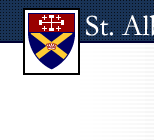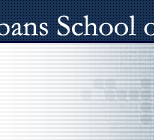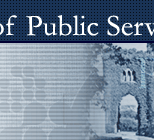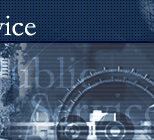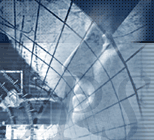|
On Sunday, June 23rd, 28 rising seniors from 14 states and
1 foreign country arrived at St. Albans and moved in—the
boys into the St. Albans dorm and the girls into the College
of Preachers. The inaugural class of the St. Albans School
for Public Service, the brainchild of Headmaster Vance Wilson,
was off and running.
It was two years ago that Mr. Wilson approached the Governing
Board with an idea—a St. Albans summer program aimed
at giving high school students from across the country a glimpse
into the possibilities of public service. Mr. Wilson believed
that it was critical that St. Albans draw on its strengths
and inspire in students a desire to serve others: “Public
service is one particular aspect of service our School is
famous for, and I believe we should share our experience and
wisdom about public service with young people cross the country.”
Mr. Wilson earned Governing Board backing, and the idea quickly
gained momentum. Wilson talked at length with Ted Eagles,
St. Albans history chair emeritus, about ideas for the program
and hired Mary Anne Waikart to direct the program and recruit
its Advisory Board, its teachers and its students.
Two years
of planning paid off this summer, when the program, dubbed
the St. Albans School of Public Service, finally kicked
off.
The School accepted 29 students, attracted by a combination
of Washington, public service and St. Albans, into its first
class. For four weeks the students were immersed in rigorous
study of what it means to be a public servant in our culture
and the role and importance of our form of government in
society today. Through a series of field trips, case studies,
class
discussions, student debates and guest speakers, SPS illuminated
the significance of a democracy and helped its students
understand
the role they might play to sustain and strengthen it .
Students arrived on Sunday, June 23, and were given the
afternoon to settle into their new homes. After orientation
and an early dinner, the students were treated to an exclusive
performance by the political satire group The Capitol Steps
in Trapier Theater. The Steps sang and acted out parodies
of current political figures ranging from Bill Clinton to
Tom Ridge and George W. Bush to Jacques Chirac. Bill Strauss,
the founder of the Capitol Steps, then talked with the students
about the place and importance of political satire today and
the millenial generation. The new class was both impressed
and amused: “The Capitol Steps were great, and Bill
Strauss is one of the coolest and most down-to-earth adults
that I know,” said Emily Hubbard, an SPS student from
Memphis, Tennessee. After a group-building ropes course exercise
on Monday, students began a demanding four weeks of work and
study the next day.
The program’s schedule reflected both an emphasis
on traditional learning and a desire to help the students
experience what they were studying. A typical day began with
three hours in the classroom, spent in any number of ways.
One of the most popular was case studies. They provided the
students a look at past court cases, such as ABC v. Food
Lion
and the Beavis and Butthead case, that raised issues about
the interpretation of the Constitution. Case discussions
wre lead by Mrs. Jacqueline Grazette, who developed much
of the curriculum, and by Mr. David Emanuel. After a case
study of the Miranda case heard by the Supreme Court,
students
paid a visit to the Court. They met with deputy clerk Francis
Larson,
who answered questions and gave them a tour of the courtroom.
Student Zach Brisson of North Carolina identified this as
“our best study visit . . . as the deputy clerk had
so much information and he was so knowledgeable. Also, sitting
in the actual gallery was very impressive.”
Morning offerings were varied. The first two mornings students
followed their studies of the Founding Fathers and the office
of the President and his cabinet with lunch with current White
House staffers. Other mornings visiting speakers challenged
the students to consider a wide range of subjects: media coverage
of the Middle East, taking on big tobacco, the roles of government
agencies such as the CIA, the NSC and the FBI, and future
education planning. Classroom time was also spent analyzing
the United States’ role in foreign policy—our
struggle with China over human rights, our position in the
United Nations and our role in maintaining peace between Israel
and Palestine. Workshops focused on Congressional priority
setting and on the role of the Attorney General and the Justice
Department. Students also debated current political issues,
such as capital punishment, after hearing from advocates on
both sides of the issue. Although these activities required
work from the students both in the classroom and in preparing
for discussions and debates, the school’s aim was not
to swamp them. “SPS was not that much work. There was
not much homework besides reading case studies and preparation
for class. Usually we had allotted time to do our studies,
and the studies did not cut into our free time,” said
Tyler Robinson, a student from Huntsville, Alabama.
The afternoon was typically more hands-on and more work-free.
SPS took advantage of its location in the heart of Washington
to take study visits to places nearby that could speak to
what the students were learning about. The class spent a
day
touring the US Naval Academy in Annapolis, Maryland, following
up with a visit to the Maryland State House. They were shown
the White House press room and the rest of the West Wing
and were even allowed to see the Oval Office: “My
favorite part of the tour was getting to see the Oval Office.
It was
pretty exciting,” said one. After a tour of the Australian
Embassy and a lesson on the role of ambassadors and the
diplomatic
corps, the class attended a reception in their honor with
the Australian Ambassador at his residence. The class toured
the FBI building
and
saw
DNA fingerprinting labs there. They met with Congressman
Harold
Ford (D-TN) and Senator Bill Frist (R-TN) and toured the
Senate floor with him. There was also a series of historical
outings,
including visits to a Civil War battlefield, Monticello,
and Mount Vernon.
In addition to seeing how government works, students also
studied and witnessed how government is delivered to the people.
The class met with Kathleen Matthews, one of the anchors for
Channel 7 News and a St. Albans and NCS parent. They also
met Sharon Rockefeller who showed them around the set of the
McNeil/Lehrer News Hour, PBS’ nightly news show. Colbert
King, an editorialist with The Washington Post, talked to
them about newspapers’ roles in delivering the news.
More was to follow. Students visited the set of “Hardball
with Chris Matthews” and watched the taping of “Meet
the Press” with Tim Russert—both St. Albans fathers.
If the visits were meant to impress upon the students how
large and variable a media job can be and how influentical
the press is, it did just that. According to Hubbard, the
student from Memphis, “By visiting a wide variety of
media styles I was able to see how each type played a significant
role. Some of the news shows we visited were strictly for
informative purposes and others more for entertainment. Visiting
the newspaper was also interesting because it gave us a look
at the work that goes into it.” Tyler Robinson, from
Huntsville, Alabama, added, “The best part of watching
the press work was going to the room where the technical staff
made sure that everything was well-timed, looked good, etc.
Those people seem to do more work than the anchors.”
SPS students were absorbed by more than classes and study
visits. Most evenings were spent in the “Presidential
Game,” a mock presidential election in which the students
assumed roles of candidates, campaign managers, political
assistants, potential voters, etc. The students were given
lists of actual politicians from all parties and allowed to
nominate themselves in place of one of them to make a run
for President. In all, five students nominated themselves,
running in their own names but taking on the profiles of politicians
such as Susan Collins, Bill Frist, Barbara Boxer, and John
Kerry. They were joined by two other politicians un-represented
by students—Joe Lieberman and George Pataki—in
order to make their Presidential primaries more competitive.
The student candidates then set out to run their campaigns.
With help from other students acting as political aids,
media consultants, and campaign organizers, the candidates
plotted out a week-long primary campaign schedule replete
with visits to local politicians and ads made on Power Point.
Dr. Shurmer used the ads and campaign schedule to determine
each candidate’s popularity and chances of success
in different states. Mr. Constantine televised interviews
of
the candidates which were broadcast to the rest of the class.
Students watching the broadcasts from the computer room
called
in with questions for the candidates. Their answers would
further influence how the candidates were perceived in
each
state and the support they would receive there. Students,
families and friends were able to follow the campaign through
daily press releases, postings and articles about the candidates,
campaign stops, position statements, political missteps
and
endorsements coups which were developed and put on the SPS
website by Dr. Shurmer. Using data from each
candidate’s campaign itinerary, television and radio
ads, and the televised interviews, as the week passed, Dr.
Shurmer determined a winner from among the students and real
politicians for each state’s primary.
When the primary dust settled, three candidates remained
for the general election: Zach Brisson, a student from Charlotte,
North Carolina, who was running as Republican Senator Bill
Frist of Tennessee; Bernard Holloway, from Mitchville, Maryland,
who was running as Democratic Senator John Kerry of Massachusetts;,
and Brittany Alexander, from Temple Hills, Maryland who was
running as an Independent candidate. Each candidate turned
to creating a country-wide campaign plan, drawing on their
plans in the primaries. There was also a “televised
national debate” between Brisson (R) and Holloway (D),
during which the two debated issues such as health care, the
Middle East, and the failing stock market. At the end of the
last week of the School, the general election was held. According
to the Game’s rules, the outcome in 47 states was determined
by computer simulation, while the remaining three states
decided
winners through a political trivia match between the three
candidates which was designed to test overall political knowledge.
Brisson’s comments about the Game were highly complimentary:
“The Presidential Game was a great experience. There
is no doubt it was fun with all the mock debates and speeches
etc. As far as realism goes, there were definitely some unrealistic
parts, especially when it came to the actual election itself,
but I definitely think that SPS should keep the game as part
of the curriculum. The game also really helped me form really
tight relationships with the people I worked with.”
Those who did not nominate themselves as candidates were
equally enthusiastic. “Although I was not a candidate,
I enjoyed the presidential game, especially towards the
end, because
it was interesting to see how the candidates reacted to statements
meant to give them a bad wrap. It was interesting and well-run.
I really had a great time, I would definitely recommend SPS
to anyone,” said Tyler Robinson.
Other SPS graduates agreed with Robinson, giving SPS high
marks for being both educational and fun. But according
to
Mr. Wilson, SPS, entering its second year, still requires
slight tweaking. Wilson, who was generally pleased with
how
things went and how smoothly the program ran, offered this
critique, “We had a magnificent first year—the
students were brilliant and dedicated, the curriculum was
unusual and interesting and the public servants were generous
with their time and support. But we need to let mor schools
know about the program and continue to strenthen the curriculum.
We also need the weather to be cooler.”
|
